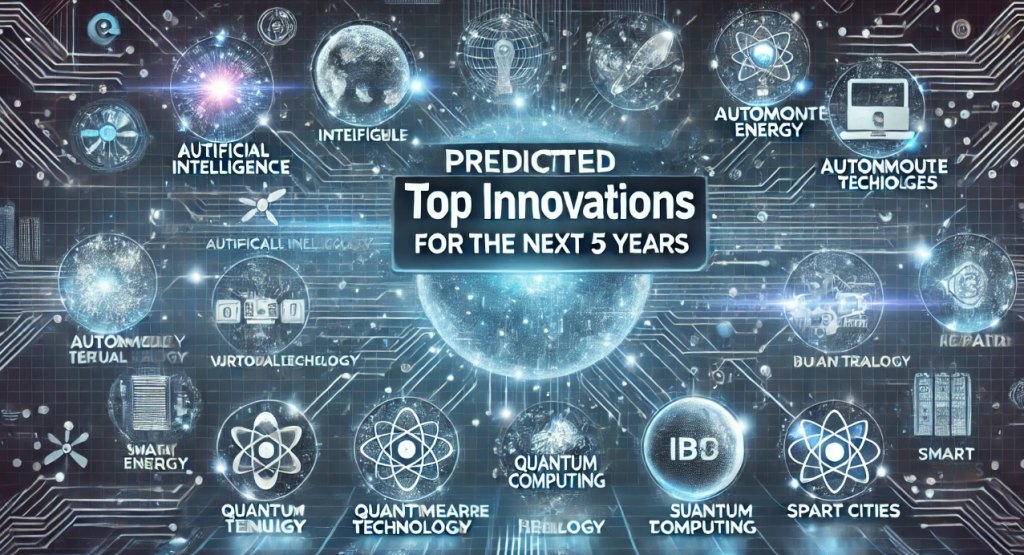Based on the trajectory of technological advancements over the last 30 years, here is a comprehensive study of the top 10 innovations that are likely to emerge in the next five years.
1. Advanced Artificial Intelligence and Machine Learning

Overview:
Artificial Intelligence (AI) and Machine Learning (ML) are expected to advance significantly, leading to systems that can perform complex tasks with higher accuracy and efficiency than ever before.
Potential Applications:
- Autonomous Vehicles: Improved navigation and decision-making.
- Medical Diagnostics: Enhanced accuracy in detecting diseases.
- Personalized Education: Tailored learning experiences for students.
- Advanced Robotics: More capable and versatile robots.
Impact:
- Society: AI will become more integrated into daily life, potentially surpassing human capabilities in specific domains.
- Economy: Increased productivity and the creation of new markets and job opportunities.
2. Quantum Computing
Overview:
Quantum computing is poised to transition from theoretical research to practical applications, providing computing power far beyond current classical computers.
Table: Potential Quantum Computing Applications
| Application | Description |
|---|---|
| Cryptography | Unbreakable encryption methods |
| Drug Discovery | Simulation of complex molecular structures |
| Financial Modeling | Rapid analysis of vast datasets for market predictions |
| Climate Simulation | Detailed modeling to predict climate change effects |
Impact:
- Industry: Revolutionize fields requiring massive computational power.
- Research: Enable breakthroughs in scientific research and problem-solving.
3. Augmented Reality (AR) and Virtual Reality (VR) Integration
Overview:
AR and VR technologies will see seamless integration into daily activities, enhancing work, entertainment, and education.
Potential Applications:
- Remote Work: Virtual collaboration environments.
- Virtual Tourism: Immersive travel experiences.
- Gaming: Advanced interactive gaming.
- Education: Interactive and immersive learning modules.
Impact:
- Lifestyle: Enriched user experiences in both personal and professional contexts.
- Business: New opportunities in content creation and service delivery.
4. 5G and Beyond Networks
Overview:
The widespread adoption of 5G technology, followed by the initial roll-out of 6G, will revolutionize internet connectivity with faster and more reliable networks.
Table: 5G vs. 6G
| Feature | 5G | 6G (Future) |
|---|---|---|
| Speed | Up to 10 Gbps | Up to 1 Tbps |
| Latency | ~1 ms | Sub-millisecond |
| Connectivity | Enhanced IoT connectivity | Ubiquitous connectivity |
Impact:
- Technology: Enable the full potential of IoT, smart cities, and autonomous systems.
- Economy: Drive economic growth through new industries and services.
5. Biotechnology and Genetic Engineering
Overview:
Advancements in biotechnology, particularly in CRISPR and gene editing, will lead to precise genetic modifications and treatments.
Potential Applications:
- Genetic Disease Treatment: Cure for hereditary conditions.
- Personalized Medicine: Tailored treatments based on genetic profiles.
- Agricultural Enhancements: Genetically modified crops with improved yields.
- Synthetic Biology: Creation of new biological systems and organisms.
Impact:
- Healthcare: Transformative treatments for previously incurable diseases.
- Agriculture: Increased food security and sustainable farming practices.
6. Sustainable Energy Solutions
Overview:
Innovations in generating, storing, and distributing renewable energy will make sustainable energy more efficient and affordable.
Potential Applications:
- Solar Power: Advanced photovoltaic cells.
- Wind Energy: High-efficiency turbines.
- Energy Storage: Improved battery technology.
- Smart Grids: Efficient energy distribution networks.
Impact:
- Environment: Reduced reliance on fossil fuels and lower carbon emissions.
- Economy: Growth in the green energy sector and job creation.
7. Nanotechnology
Overview:
Nanotechnology will bring advanced nanomaterials and devices with applications across medicine, electronics, and environmental protection.
Potential Applications:
- Medicine: Targeted drug delivery systems.
- Electronics: Smaller, faster, and more efficient devices.
- Environment: Advanced filtration and pollution control systems.
Impact:
- Healthcare: Revolutionize treatments and diagnostic methods.
- Industry: Enable the creation of innovative products and materials.
8. Autonomous Systems
Overview:
Fully autonomous systems, beyond vehicles, will become commonplace, including drones, robotic assistants, and industrial automation.
Potential Applications:
- Transportation: Autonomous public transit and delivery drones.
- Healthcare: Robotic surgery and patient care.
- Manufacturing: Fully automated production lines.
Impact:
- Labor: Shift in job roles towards more oversight and management positions.
- Efficiency: Increased productivity and precision in various sectors.
9. Brain-Computer Interfaces (BCIs)
Overview:
BCIs will allow direct communication between the brain and external devices, enhancing cognitive and physical abilities.
Potential Applications:
- Medical Rehabilitation: Neuroprosthetics for disabled individuals.
- Human Augmentation: Enhanced cognitive functions.
- Communication: New methods for individuals with communication impairments.
Impact:
- Healthcare: Significant improvements in quality of life for patients with severe disabilities.
- Technology: New interfaces and methods of interaction with devices.
10. Advanced Materials
Overview:
Development of new materials with unprecedented properties, such as super-strength, lightness, and self-healing capabilities.
Potential Applications:
- Construction: Stronger and lighter building materials.
- Aerospace: Advanced materials for spacecraft and aircraft.
- Consumer Electronics: Durable and flexible electronic devices.
Impact:
- Industry: Enable new engineering possibilities and innovations.
- Environment: Sustainable and resilient materials for various applications.
Conclusion
These ten predicted innovations highlight the transformative potential of technology in the next five years. From advancements in AI and quantum computing to breakthroughs in biotechnology and sustainable energy, these innovations will shape the future landscape, driving significant societal, economic, and environmental impact. By staying ahead of these trends, businesses and individuals can prepare for the opportunities and challenges that lie ahead.